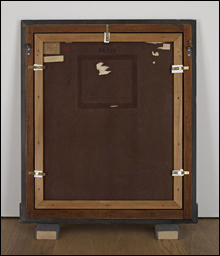
“VERSO (American Gothic)” Mixed-media object by Vik Muniz, 2008. |
In the art of deception lies the potential to destabilize perceptions of reality, if only momentarily. An expert wielder of this art can unravel a paradigm just long enough to implant new information while a frantic mind searches for logic, manipulating the instant artifice is recognized. Seems requisite for any conceptual artist's toolkit. An initial misreading encourages a more active engagement with a work, asking the viewer to struggle with an idea or a process. This prolongation, however, has the potential for patronizing teaching moments, which fortunately are not heavy-handed in "Trompe L'oeil: False Documents & Other Illusions," the second installment of the "Circa" series at the Portland Museum of Art.
Here, a roster of 13 artists wax illusory to playful or profound effect. Re-appropriating the technique of trompe l'oeil in a host of diverse media, these artists largely question art objects. They subvert the Dada concept of "readymades" by requiring meticulous intervention of materials to create something rather ordinary, or by implying value or "artfulness" lies not necessarily in the inherent quality of an object, but in the number of people who believe in it, and thus lend it great care. "False Documents" asks the viewer to care about the mundane, to observe the compositions created by Carl Haase's discarded and crumpled candy wrappers, the texture of Marti Cormand's torn corrugated cardboard, or Susan Collis's installation hardware with the same appreciation and consideration we might bestow a hyper-realistic painting.
Vik Muniz scrupulously replicates the backs of major paintings and photographs, denying the viewer a look at a recognizable image and what it represents, but instead asking for consideration of the history of the object itself. In "Verso (American Gothic)", the famous painting by Grant Wood appears to be leaning against the wall of the gallery, back to the audience. The iconic image, of course, is not the subject here. After studying the original work, Muniz recreated every minutia of the work's frame and backing. Hardware, inventory codes, handwritten notes, faded stickers, remnants of adhesive, and sun-bleach spots are fabricated convincingly so as to tell a story of where the painting has been and who has painstakingly cared for it, while simultaneously undermining the status of the object, reminding us it is simply oil and wood.
Also recording the history of a revered item, this time on a personal level, Steve Wolfe fabricates books of cultural significance. With remarkable skill, Wolfe incorporates every crease, tear, and stain into his painted modeling-paste-and-wood sculptures, highlighting the individual relationship one might have with a mass-produced object. The unique scars of use rendered in a reproduction of Emile Zola's "L'Oeuvre" record the intellectual experience offered by the sample of material culture.
Where the "aha!" moment is subtle in both Muniz's and Wolfe's reproductions, the Yes Men (and Friends) seize the emotional potential of that very moment to inspire political and social action. In November 2008 the performance artist duo and a team of writers, activists, and artists distributed an alternative edition of the New York Times for free in Manhattan. This complete paper, dated July 4, 2009, boasted hopeful headlines such as "Iraq War Ends," and "Maximum Wage Law Succeeds." The articles contained "All the news we hope to print." This stunt aimed to make change tangible and to elicit an excitement that might shift to responsibility, an impetus for action. A copy of the paper, "Because We Want It," is in the gallery.